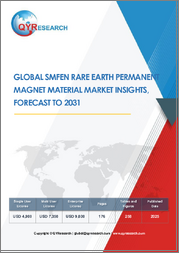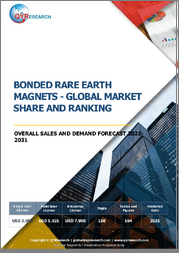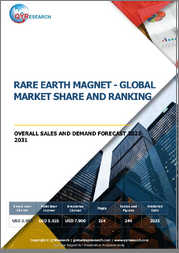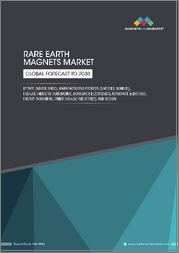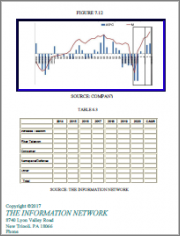
|
시장보고서
상품코드
1642767
희토류 원소 시장 보고서 : 용도별, 지역별(2025-2033년)Rare Earth Elements Market Report by Application (Magnets, NiMH Batteries, Auto Catalysts, Diesel Engines, Fluid Cracking Catalyst, Phosphers, Glass, Polishing Powders, and Others), and Region 2025-2033 |
||||||
세계의 희토류 원소 시장 규모는 2024년 124억 달러에 달했습니다. 앞으로 IMARC Group은 2025-2033년 동안 12.83%의 성장률(CAGR)을 보이며 2033년까지 시장 규모가 371억 달러에 달할 것으로 예상하고 있습니다. 지속 가능하고 깨끗한 에너지 솔루션에 대한 개인들의 성향이 높아지고 전 세계적으로 소비자 가전제품이 널리 보급되면서 시장 수요를 견인하는 주요 요인으로 작용하고 있습니다.
희토류 원소는 15개의 란타노이드와 스칸듐, 이트륨으로 구성된 17개의 화학 원소로 구성된 그룹입니다.희토류라는 이름과는 달리 대부분의 희토류 원소는 지각에서 특별히 희귀하지 않습니다. 희토류 원소를 '희귀'하게 만드는 것은 채굴 및 정제가 어렵기 때문입니다. 희토류 원소는 독특한 자기, 촉매 및 발광 특성으로 잘 알려져 있어 다양한 첨단 기술 응용 분야에서 매우 중요합니다. 스마트폰과 가전제품부터 재생 에너지 시스템과 첨단 군사 기술에 이르기까지 다양한 제품의 필수 구성 요소입니다.
소비자 가전, 자동차, 재생 에너지 등 다양한 산업 분야의 중요한 기술 혁신은 전 세계 희토류 원소 시장의 성장을 이끄는 주요 요인 중 하나입니다. 희토류 원소는 배터리, 자석, 전자 디스플레이와 같은 부품 제조에 필수적이며, 기술 발전에 따라 수요가 증가하고 있습니다. 또한 레이더 시스템, 제트 엔진, 미사일 유도 시스템에 사용되는 고성능 소재를 생산하는 데 필수적이므로 방위 분야에서의 역할도 시장을 주도하고 있습니다. 친환경 에너지에 대한 강조가 커지고 있는 것도 주요 성장 요인으로 작용하고 있습니다. 희토류 원소는 풍력 터빈과 전기 자동차 생산에 필수적이며, 탄소 배출을 줄이려는 글로벌 지속가능성 목표에 부합합니다. 또한 희토류 원소 공급이 특정 지역에 집중되어 있어 공급망에 잠재적인 병목 현상이 발생하기 때문에 지정학 및 무역 관계도 시장에 큰 영향을 미칩니다. 또한 희토류 원소를 사용하는 기술에 대한 보조금과 전략적 비축을 포함한 정부 정책으로 인해 전 세계적으로 시장에 대한 긍정적인 전망이 나오고 있습니다.
희토류 원소 시장 경향 및 촉진요인
상당한 기술 진보
희토류 수요의 가장 강력한 원동력 중 하나는 기술 혁신의 끊임없는 속도입니다. 희토류 원소는 수많은 첨단 기술 애플리케이션에 없어서는 안 될 필수 요소입니다. 예를 들어 풍력 터빈에 사용되는 강력한 자석에는 네오디뮴이 필요하고, 하이브리드 및 전기 자동차 배터리에는 란탄이 사용되는 경우가 많습니다. 이 외에도 스마트폰, 태블릿, 노트북 등 많은 전자 기기에는 더 작고 효율적인 부품을 가능하게 하는 희토류 원소가 포함되어 있습니다. 이러한 기술이 계속 발전하고 채택률이 높아짐에 따라 희토류 원소에 대한 수요가 증가하여 시장 가치가 더욱 상승하고 있습니다.
친환경 에너지에 대한 노력 증가
환경 지속 가능성은 전 세계 정부 및 조직의 초점이 되고 있으며, 청정 에너지 기술에 대한 수요를 자극하고 있습니다. 희토류 원소는 이 분야에서 중요한 역할을 합니다. 네오디뮴과 디스프로슘과 같은 원소는 풍력 터빈의 기능에 필수적인 영구 자석 생산에 사용됩니다. 마찬가지로 운송 부문의 전기화 추진은 배터리와 전기 모터에 사용되는 희토류 원소에 대한 수요도 증가시킵니다. 각국이 야심찬 기후 목표를 달성하고 재생 에너지원으로 전환하기 위해 노력하면서 이러한 원소 시장이 활기를 띠고 있습니다.
방위용도 증가
방위용도에서 희토류 원소 수요는 시장 성장에 크게 기여하고 있습니다. 이러한 요소는 다양한 고급 군사 기술에 필수적입니다. 예를 들어, 희토류는 정밀 유도탄, 레이더 시스템, 항공 전자 공학의 제조에 필수적인 구성 요소입니다. 또한 암시 고글 및 기타 광학 장비용 특수 유리 제조에도 사용됩니다. 지정학적 긴장이 높아지고 각국이 방위능력 근대화에 더 투자하게 되면 희토류의 필요성이 높아집니다. 고성능 재료에 대한 군사적 의존은 이러한 원소를 전략적 우선순위로 삼고, 종종 비축과 장기 조달 계약으로 이어집니다.
목차
제1장 서문
제2장 조사 범위와 조사 방법
- 조사의 목적
- 이해관계자
- 데이터 소스
- 1차 정보
- 2차 정보
- 시장 추정
- 상향식 접근
- 하향식 접근
- 조사 방법
제3장 주요 요약
제4장 희토류 원소란 무엇인가
제5장 희토류 원소 : 정말로 희소한가?
- 매장량 추정
- 얼마나 지속되는지
제6장 희토류 원소: 채굴 경제
- 광산 평가 : 품위와 조성이 열쇠
- 새로운 프로젝트 개발 : 몇 년이 걸릴 수도 있다
- 희토류 광업 비용 : 주로 위치와 등급 개발
- 인프라와 자본 비용
- 운영 비용
- 주요 프로젝트
- Arafura Resources Limited-Noland Project
- Nechalacho Rare Earth Elements Project
- Kvanefjeld Project-Greenland Minerals & Energy Limited
- Dubbo Zirconia-Alkane Resources Limited
- 채굴과 가공
- 광업
- 하류 처리
- 가격
- 희토류 원소 가격에 영향을 미치는 요인
- 과거 가격
- 가격 예측
제7장 중국의 역할 세계의 희토류 원소 시장
- 중국은 희토류 원소를 독점하고 있다
- 중국의 채굴 비용은 다른 희토류 생산국에 비해 상당히 낮다
- 광산 노동자는 적절한 노동 기준과 환경 규제의 부족으로부터 이익을 얻어 왔다
- 중국은 다른 희토류 원소 생산국에 비해 사내의 전문지식이 현저히 높다
- 중국은 희토류 원소 시장에서 글로벌 지배력을 유지하기 위해 전략적으로 생산 쿼터를 늘리고 있다.
- 중국은 고부가가치 상품의 수출국이되는 것을 목표로한다.
제8장 세계의 희토류 원소 시장
- 희토류 원소의 총 판매량과 생산량
- 희토류 원소의 생산량 : 지역별
- 현재 가동중인 광산
- 바얀오보, 중국
- 중국, 용남
- 중국 장무
- 인도
- 브라질 동해안
- 라하트, 말레이시아
- 마운트 웰드, 호주
- 마운틴 패스, 미국
- 노랜즈, 호주
- 스틴 캄프 스쿠랄, 남아프리카
- 쿠바네피에르도, 그린란드
- 베트남, 돈파오
- 다보질코니아, 호주
- 가동 가능한 지뢰의 가능성
- 네차라초, 캐나다
- 현재 가동중인 광산
- 희토류 원소의 소비량 : 지역별
- 중국
- 일본과 동북아
- 미국
제9장 희토류 원소공급과 수요
- 가까운 미래에 공급 부족에 직면하는 원소
- 프라세오디뮴
- 요소 개요 및 공급 위험
- 공급과 수요
- 네오디뮴
- 요소 개요 및 공급 위험
- 공급과 수요
- 프라세오디뮴
- 가까운 미래에 공급 과잉이 되는 원소
- 테르븀
- 요소 개요 및 공급 위험
- 공급과 수요
- 이트륨
- 요소 개요 및 공급 위험
- 공급과 수요
- 랜턴
- 요소 개요 및 공급 위험
- 공급과 수요
- 세륨
- 요소 개요 및 공급 위험
- 공급과 수요
- 디스프로슘
- 요소 개요 및 공급 위험
- 공급과 수요
- 사마륨
- 요소 개요 및 공급 위험
- 공급과 수요
- 유로퓸
- 요소 개요 및 공급 위험
- 공급과 수요
- 테르븀
제10장 시장 : 용도별
- 자석
- 니켈 수소 전지
- 자동차 촉매
- 디젤 엔진
- 유동분해 촉매
- 인광체
- 유리
- 연마 파우더
- 기타 용도
제11장 이온 흡착 점토의 채굴과 가공의 개요
- 현재의 기술
- RE 산화물 처리에 걸리는 일반적인 비용
제12장 공급 부족의 가능성을 극복한다.
- 비축
- 재활용
- 대체
- 원재료 부족 대책 : 희토류의 소비자 각사
제13장 경쟁 구도
- 시장 구조
- 주요 기업
- 주요 기업 프로파일
- Lynas Corporation Ltd.
- Arafura Resources Limited
- Great Western Minerals Group Ltd.
- Avalon Advanced Materials Inc.
- Greenland Minerals Ltd
- Alkane Resources Ltd
- Neo Performance Materials
- Iluka Resource Limited
- IREL(India)Limited
- Canada Rare Earths Corporation
The global rare earth elements market size reached USD 12.4 Billion in 2024. Looking forward, IMARC Group expects the market to reach USD 37.1 Billion by 2033, exhibiting a growth rate (CAGR) of 12.83% during 2025-2033. The rising inclination among individuals towards sustainable and clean energy solutions, along with the widespread usage of consumer electronics across the globe, is primarily propelling the market demand.
Rare earth elements are a group of 17 chemical elements that consist of the 15 lanthanides, along with scandium and yttrium. Despite their name, most rare earth elements are not particularly rare in the Earth's crust. What makes them "rare" is the difficulty associated with mining and refining them. These elements are known for their unique magnetic, catalytic, and luminescent properties, which make them critical in various high-technology applications. They are essential components in a wide array of products, ranging from smartphones and consumer electronics to renewable energy systems and advanced military technologies.
Significant technological innovations across various industries, including consumer electronics, automotive, and renewable energy, represent one of the key factors driving the growth of the rare earth elements market across the globe. Rare earth elements are crucial in manufacturing components like batteries, magnets, and electronic displays, whose demand is rising with technological advancements. The market is also driven by their role in defense applications as these elements are essential in producing high-performance materials used in radar systems, jet engines, and missile guidance systems. The growing emphasis on green energy is also acting as a major growth-inducing factor. Rare earth elements are vital in the production of wind turbines and electric vehicles, aligning with global sustainability goals to reduce carbon emissions. Additionally, geopolitics and trade relations significantly impact the market, as many rare earth element supplies are concentrated in specific regions, which are creating potential bottlenecks in supply chains. Moreover, government policies, including subsidies for technologies that use rare earth elements and strategic stockpiling, are creating a positive outlook for the market across the globe.
Rare Earth Elements Market Trends/Drivers:
Significant technological advancements
One of the most potent drivers of demand for rare earth elements is the relentless pace of technological innovation. These elements are indispensable in a plethora of high-tech applications. For instance, the powerful magnets used in wind turbines require neodymium, while hybrid and electric vehicle batteries often employ lanthanum. In addition to this, many electronic devices, such as smartphones, tablets, and laptops contain rare earth elements that enable smaller, and more efficient components. As these technologies continue to evolve and adoption rates climb, the demand for rare earth elements is escalating, which is further driving up the market value.
Rising green energy initiatives
Environmental sustainability is becoming a focal point for governments and organizations worldwide, stimulating the demand for clean energy technologies. Rare earth elements play a critical role in this sector. Elements like neodymium and dysprosium are used in the production of permanent magnets that are integral to the function of wind turbines. Similarly, the drive for electrification of the transport sector also boosts demand for rare earth elements used in batteries and electric motors. As nations strive to meet ambitious climate targets and transition to renewable energy sources, the market for these elements is fueling.
Rising defense applications
The demand for rare earth elements in defense applications significantly contributes to the market growth. These elements are indispensable for a variety of advanced military technologies. For instance, rare earths are essential components in the manufacturing of precision-guided munitions, radar systems, and avionics. They are also used in the production of specialized glass for night-vision goggles and other optical equipment. As geopolitical tensions escalate and nations invest more in modernizing their defense capabilities, the need for rare earth elements rises. Military reliance on high-performance materials makes these elements a strategic priority, often leading to stockpiling and long-term procurement contracts.
Global Rare Earth Elements Market Segmentation:
Breakup by Application:
Magnets
NiMH Batteries
Auto Catalysts
Diesel Engines
Fluid Cracking Catalyst
Phosphers
Glass
Polishing Powders
Others
Magnets dominate the market
Rare earth elements, particularly neodymium, dysprosium, and samarium, play a critical role in the development of high-performance magnets. These are not ordinary magnets; they offer superior magnetic properties as compared to traditional ferrite or alnico magnets. Neodymium magnets, often combined with small amounts of dysprosium to improve temperature stability, are widely used in a variety of applications requiring strong, compact magnets. In the renewable energy sector, these magnets are essential components in wind turbine generators. Their high magnetic force allows for more efficient energy conversion, thereby maximizing the electrical output. In the automotive industry, they are used in electric and hybrid vehicle motors, contributing to both power and efficiency. These magnets are also prevalent in consumer electronics like headphones, smartphones, and hard disk drives, where their small size and high magnetic strength are particularly beneficial. Additionally, they are crucial in medical technologies such as MRI machines, which rely on strong magnetic fields for imaging.
Breakup by Region:
China
Japan & Northeast Asia
United States
China represents the largest market segment
The report has also provided a comprehensive analysis of all the major regional markets, which include China, Japan & Northeast Asia, and the United States. According to the report, China accounted for the largest market share.
In China, which controls a significant portion of the global supply of rare earth elements, several factors drive the market, both domestically and internationally. China has a booming electronics manufacturing sector that heavily relies on rare earth elements. As a global hub for consumer electronics, the internal demand for these elements is high. The Chinese government is implementing strategic policies to regulate and promote the rare earth industry. These include export quotas, strategic stockpiling, and subsidies to encourage domestic production. China's dominant position in the rare earth supply chain allows it to impact global prices and availability. This creates a virtuous cycle, which is attracting further investment into mining and processing facilities within the country. China is heavily investing in renewable energy technologies, such as wind turbines and electric vehicles, which require rare earth elements. This aligns with the country's ambitious environmental goals. Investments in research and technology aim to make the extraction and processing of rare earth elements more efficient and environmentally sustainable, which is maintaining China's competitive edge.
Competitive Landscape:
In the rare earth elements market, key players are engaging in a range of strategic initiatives to strengthen their position and capitalize on growing demand. This includes investments in research and development to enhance extraction technologies and improve the efficiency of refining processes. Companies are also exploring partnerships and collaborations, not just with other mining and chemical firms, but also with end-users like technology companies, defense contractors, and renewable energy providers. Some leading players are working closely with governments to ensure stable supply chains, especially given the geopolitical sensitivities surrounding rare earth elements. Strategic stockpiling and long-term contracts are becoming more common as both companies and nations aim to mitigate supply risks. Additionally, market leaders are expanding their geographical footprint to tap into emerging markets where demand is rising due to technological adoption and industrial growth. Diversification of supply sources is also a key strategy, aimed at reducing dependence on specific regions.
The report has provided a comprehensive analysis of the competitive landscape in the market. Detailed profiles of all major companies have also been provided. Some of the key players in the market include:
Lynas Corporation Ltd.
Arafura Resources Limited
Great Western Minerals Group Ltd.
Avalon Advanced Materials Inc.
Greenland Minerals Ltd
Alkane Resources Ltd
Neo Performance Materials
Iluka Resource Limited
IREL (India) Limited
Canada Rare Earths Corporation
Key Questions Answered in This Report
- 1. What was the size of the global rare earth elements market in 2024?
- 2. What is the expected growth rate of the global rare earth elements market during 2025-2033?
- 3. What has been the impact of COVID-19 on the global rare earth elements market?
- 4. What are the key factors driving the global rare earth elements market?
- 5. What is the breakup of the global rare earth elements market based on the application?
- 6. What are the key regions in the global rare earth elements market?
- 7. Who are the key players/companies in the global rare earth elements market?
Table of Contents
1 Preface
2 Scope and Methodology
- 2.1 Objectives of the Study
- 2.2 Stakeholders
- 2.3 Data Sources
- 2.3.1 Primary Sources
- 2.3.2 Secondary Sources
- 2.4 Market Estimation
- 2.4.1 Bottom-Up Approach
- 2.4.2 Top-Down Approach
- 2.5 Forecasting Methodology
3 Executive Summary
4 What are Rare Earth Elements?
5 Rare Earth Elements: Are they Really Rare?
- 5.1 Reserve Estimates
- 5.2 How Long Will They Last?
6 Rare Earth Elements: Mining Economics
- 6.1 Mine Valuation: Grades & Composition are Key
- 6.2 Development of a New Project: Can Take Several Years
- 6.3 Rare Earth Mining Costs: Largely Location and Grade Development
- 6.4 Infrastructure & Capital Costs
- 6.5 Operating Costs
- 6.6 Key Projects
- 6.6.1 Arafura Resources Limited-Noland Project
- 6.6.2 Nechalacho Rare Earth Elements Project
- 6.6.3 Kvanefjeld Project-Greenland Minerals & Energy Limited
- 6.6.4 Dubbo Zirconia-Alkane Resources Limited
- 6.7 Mining and Processing
- 6.7.1 Mining
- 6.7.2 Downstream Processing
- 6.8 Prices
- 6.8.1 Factors Affecting Rare Earth Element Prices
- 6.8.2 Historical Prices
- 6.8.3 Pricing Forecast
7 China's Role in the Global Rare Earth Elements Market
- 7.1 China has a Monopoly Over Rare Earth Elements
- 7.2 Mining Costs in China Are Significantly Lower Than Other Rare Earth Producers
- 7.3 Miners Have Benefitted from the Lack of Proper Working Standards and Environmental Regulations
- 7.4 China Has a Significantly Higher In-house Expertise Compared to Other Rare Earth Producers
- 7.5 China is Strategically Increasing Production Quotas to Sustain Global Dominance in Rare Earth Elements Market
- 7.6 China Aims to Become an Exporter of Higher Value Goods
8 Global Rare Earth Elements Market
- 8.1 Total Sales and Production of Rare Earth Elements
- 8.2 Production of Rare Earth Elements by Region
- 8.2.1 Current Operational Mines
- 8.2.1.1 Bayan Obo, China
- 8.2.1.2 Longnan, China
- 8.2.1.3 Xunwu, China
- 8.2.1.4 India
- 8.2.1.5 Eastern Coast, Brazil
- 8.2.1.6 Lahat, Malaysia
- 8.2.1.7 Mt. Weld, Australia
- 8.2.1.8 Mountain Pass, United States
- 8.2.1.9 Nolans, Australia
- 8.2.1.10 Steenkampskraal, South Africa
- 8.2.1.11 Kvanefjeld, Greenland
- 8.2.1.12 Dong Pao, Vietnam
- 8.2.1.13 Dubbo Zirconia, Australia
- 8.2.2 Potential Operational Mines
- 8.2.2.1 Nechalacho, Canada
- 8.2.1 Current Operational Mines
- 8.3 Consumption of Rare Earth Elements by Region
- 8.3.1 China
- 8.3.2 Japan & Northeast Asia
- 8.3.3 United States
9 Supply & Demand of Individual Rare Earth Elements
- 9.1 Elements that will Face Supply Shortages in the Near Future
- 9.1.1 Praseodymium
- 9.1.1.1 Elements Overview & Supply Risks
- 9.1.1.2 Supply & Demand
- 9.1.2 Neodymium
- 9.1.2.1 Elements Overview & Supply Risks
- 9.1.2.2 Supply & Demand
- 9.1.1 Praseodymium
- 9.2 Elements that be Oversupplied in the Near Future
- 9.2.1 Terbium
- 9.2.1.1 Elements Overview & Supply Risks
- 9.2.1.2 Supply & Demand
- 9.2.2 Yttrium
- 9.2.2.1 Elements Overview & Supply Risks
- 9.2.2.2 Supply & Demand
- 9.2.3 Lanthanum
- 9.2.3.1 Elements Overview & Supply Risks
- 9.2.3.2 Supply & Demand
- 9.2.4 Cerium
- 9.2.4.1 Elements Overview & Supply Risks
- 9.2.4.2 Supply & Demand
- 9.2.5 Dysprosium
- 9.2.5.1 Elements Overview & Supply Risks
- 9.2.5.2 Supply & Demand
- 9.2.6 Samarium
- 9.2.6.1 Elements Overview & Supply Risks
- 9.2.6.2 Supply & Demand
- 9.2.7 Europium
- 9.2.7.1 Elements Overview & Supply Risks
- 9.2.7.2 Supply & Demand
- 9.2.1 Terbium
10 Market by Application
- 10.1 Magnets
- 10.2 NiMH Batteries
- 10.3 Auto Catalysts
- 10.4 Diesel Engines
- 10.5 Fluid Cracking Catalyst
- 10.6 Phosphers
- 10.7 Glass
- 10.8 Polishing Powders
- 10.9 Other Applications
11 Overview on Mining and Processing of Ion-Adsorption Clays
- 11.1 Current Technologies
- 11.2 Typical Costs Involved With Processing RE Oxides
12 Overcoming the Potential Shortfalls in Supply
- 12.1 Stockpiling
- 12.2 Recycling
- 12.3 Substitution
- 12.4 Material Shortfall Strategies by Various Rare Earth Consumers
13 Competitive Landscape
- 13.1 Market Structure
- 13.2 Key Players
- 13.3 Profiles of Key Players
- 13.3.1 Lynas Corporation Ltd.
- 13.3.2 Arafura Resources Limited
- 13.3.3 Great Western Minerals Group Ltd.
- 13.3.4 Avalon Advanced Materials Inc.
- 13.3.5 Greenland Minerals Ltd
- 13.3.6 Alkane Resources Ltd
- 13.3.7 Neo Performance Materials
- 13.3.8 Iluka Resource Limited
- 13.3.9 IREL (India) Limited
- 13.3.10 Canada Rare Earths Corporation






